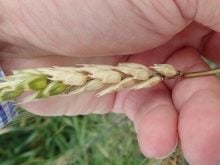A microbe found in millet fields may prove to be the key to defeating Fusarium graminearum.
Researchers at the University of Guelph, in a paper published in the journal Nature Microbiology, have shown a beneficial interaction between finger millet plants and microbes that live in their roots. This interaction seems to give the crop a natural resistance to fungal infection, something long known but little understood by the African and Asian subsistence farmers that grow the crop.
Manish Raizada, a plant agriculture professor, says the discovery could also point the way toward a natural treatment to thwart the pathogen in other important crops grown worldwide, including corn and wheat.
Read Also

Manitoba boosts stake in cereals centre to $23.5 million
Premier Wab Kinew said the additional project funds will help ‘Trump-proof’ the provincial economy.
He said the findings may help agricultural companies develop seed treatments using the microbes.
Through microscope observations, researchers learned how the mechanism works.
Sensing the pathogen near the plant roots, the microbe enters the soil and multiplies to millions of cells that form a protective barrier on the root surface.
Even more striking, Raizada said, the plant’s root hairs grow to many times their normal length. Like layers in lasagna, the root hairs and the bacterial cells form a dense mat that traps the fungus.
The researchers found that natural products of these endophytic bacteria then kill the fungus.
“This appears to be a new defence mechanism for plants,” said Raizada.
He likens it to the human immune system, with immobile plant cells “recruiting” mobile microbes to seek out and destroy pathogens.
The researchers believe this defence evolved in a kind of evolutionary arms race between the fungus and microbes.















